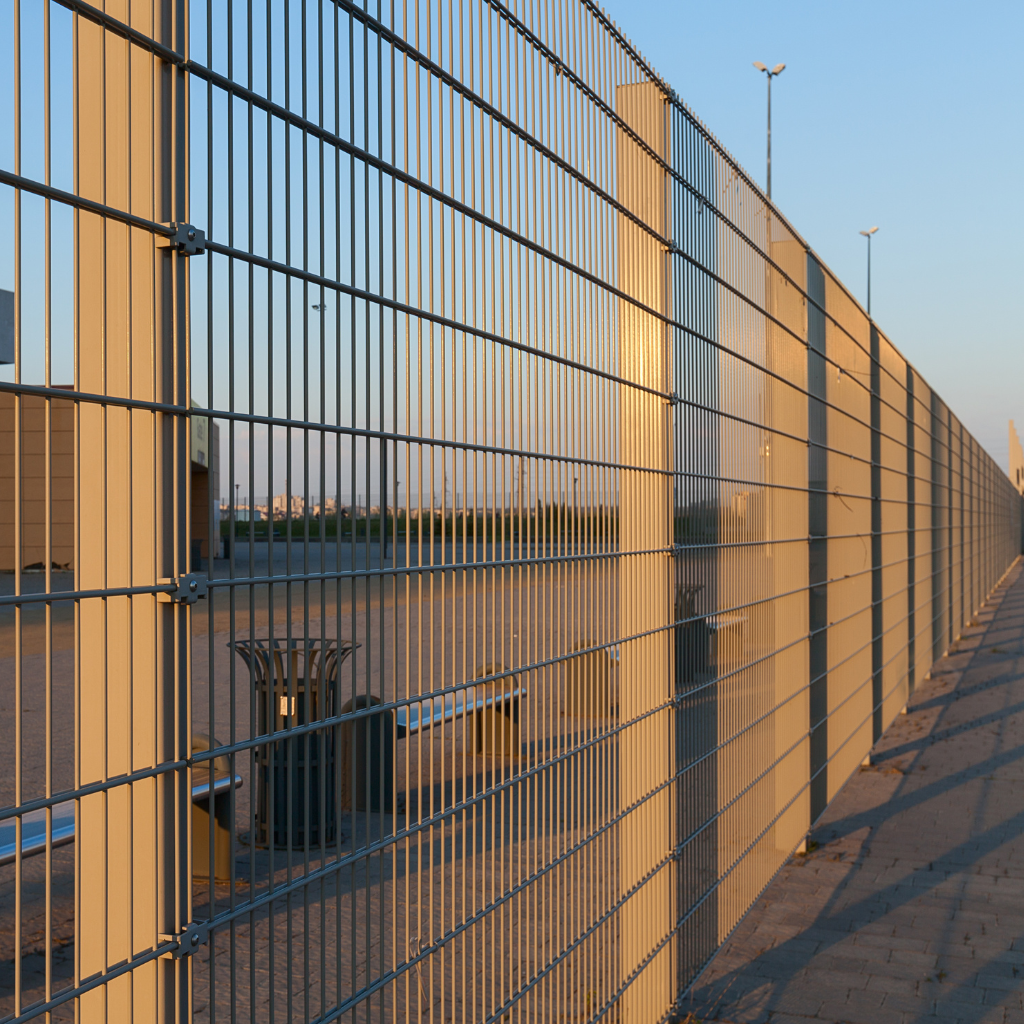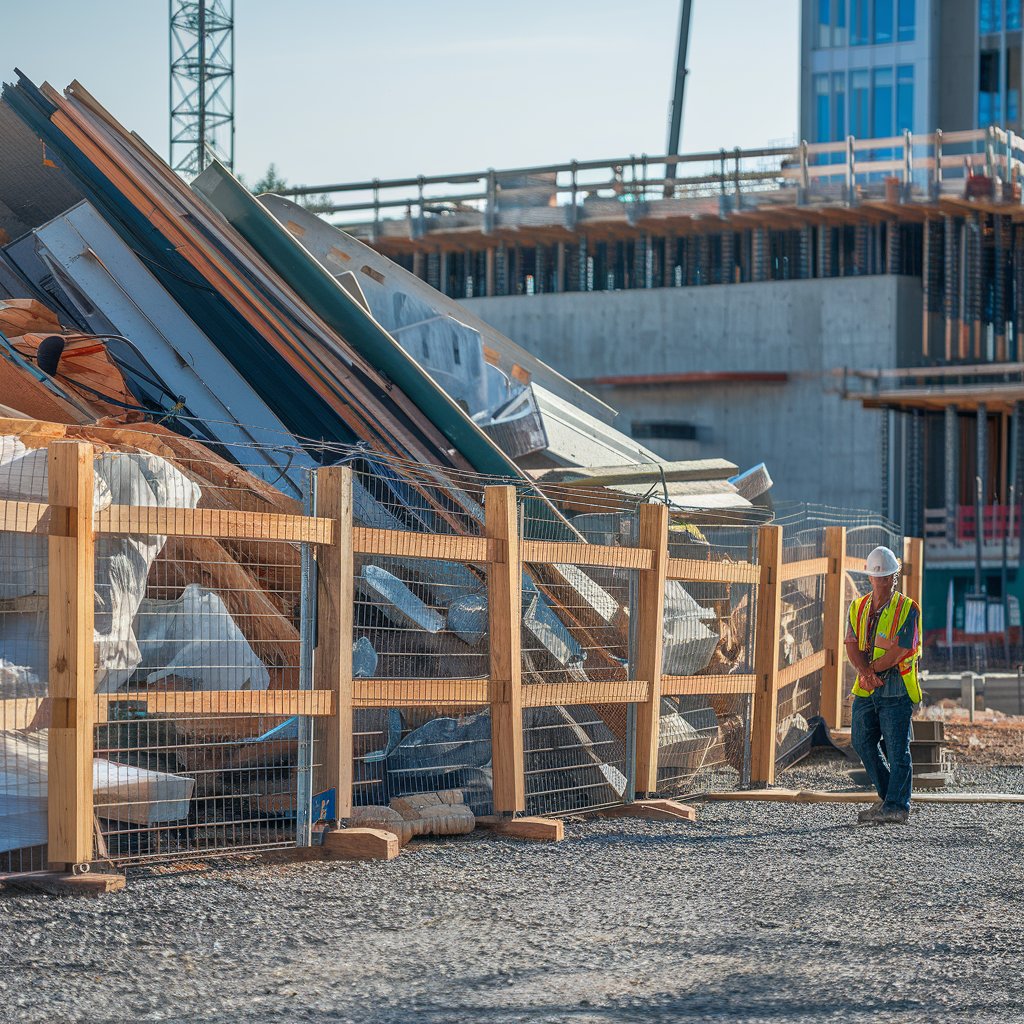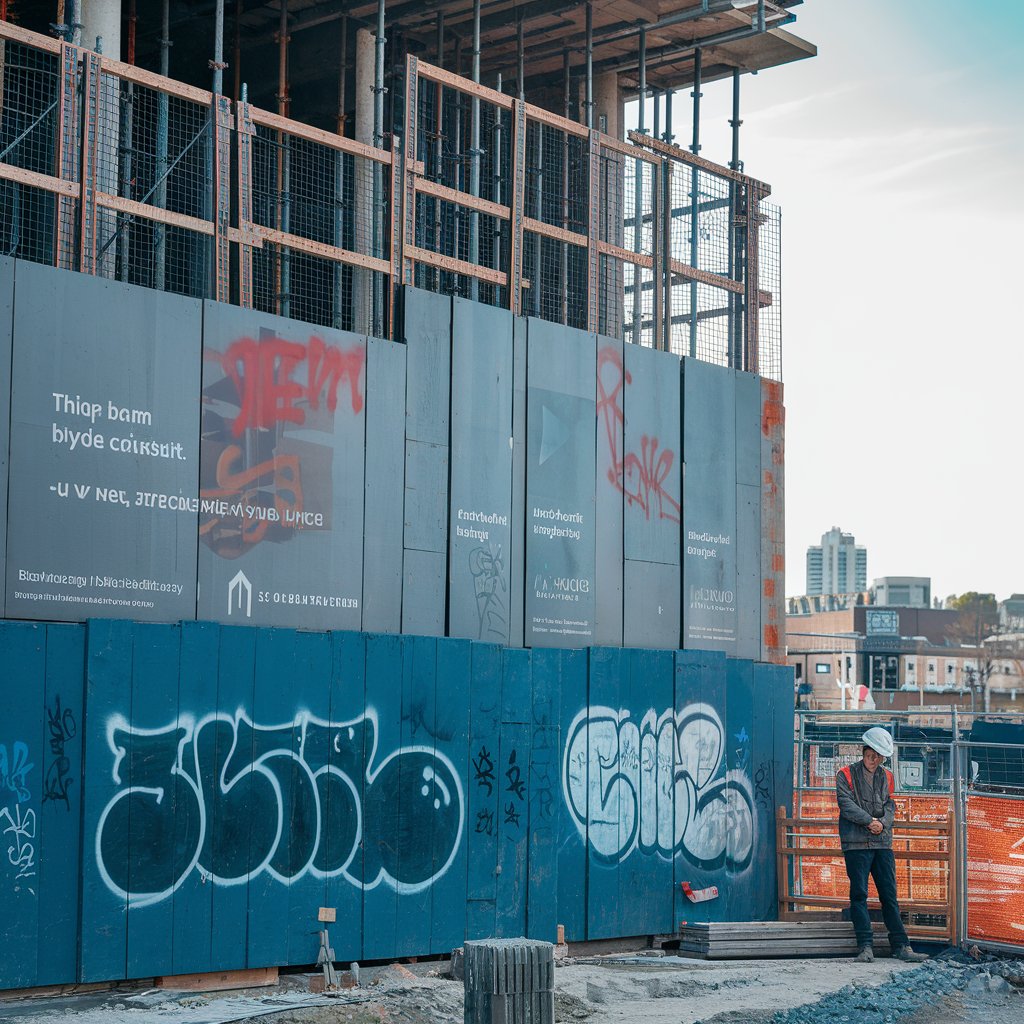Temporary fencing provides lightweight and flexible barriers for safety and security, utilising mesh panels or chain links. In contrast, construction hoarding offers a sturdy, privacy-enhancing shield made of timber or metal, ideal for security and branding. Fences allow visibility, while hoardings block it, enhancing protection. Installation and dismantling processes differ, with hoarding requiring more time and stability measures. Understanding the difference between hoarding and fencing reveals their unique security features and installation considerations for construction site boundaries.
Key Takeaways
- Hoarding offers enhanced security and privacy by blocking visibility, while temporary fencing allows visibility, reducing privacy.
- Hoarding materials are more durable and robust than lightweight materials used in temporary fencing.
- Temporary fencing is quicker and easier to install and dismantle than hoarding, which requires ground anchoring and is labour-intensive.
- Hoarding provides branding opportunities with customisable colours, whereas temporary fencing is primarily functional and less aesthetic.
- Hoarding has a higher environmental impact due to potential waste, while temporary fencing, due to its metal composition, is more recyclable.
What is a Temporary Fence, and How is it Used on a Construction Site?
A temporary fence is a versatile solution used on construction sites to secure the area and protect workers and the public.
Various types of fencing, such as mesh panels or chain links, offer distinct benefits, including ease of installation and adaptability to different terrains.
Common materials for mesh fencing include steel and plastic, chosen for their durability and cost-effectiveness.
Types of Fencing
Temporary fencing is a versatile barrier system crucial for ensuring safety and protecting secure zones on construction sites.
Various types of fencing and hoarding options are tailored to different needs. A temporary fence is often a common choice in surrounding construction sites. It typically consists of mesh fencing and fence panels that provide a temporary barrier to demarcate the perimeter.
Site hoarding, a more robust option, offers enhanced privacy and security. Mesh fencing is lightweight and easy to install, making it suitable for projects requiring quick setup and removal.
Security fencing is intended to block unauthorised entry and protect assets. Proper installation guarantees that these fencing types fulfil their intended purpose, maintaining site integrity and safety.
Benefits of Using Temporary Fences
The practicality of temporary fences lies in their ability to provide flexible and effective solutions for construction site management. They are essential for establishing a secure boundary and ensuring security and privacy. Temporary fences, often featuring anti-climb mesh, enhance site security by deterring unauthorised access. They can be quickly installed and repositioned as needed, adapting to the evolving needs of a construction site.
| Feature | Benefit | Application |
|---|---|---|
| Security | Enhances site security | Prevents unauthorised entry |
| Privacy | Shields from view | Maintains site confidentiality |
| Flexibility | Easily repositioned | Adapts to site changes |
| Accessibility | Includes gates | Controls pedestrian/vehicle flow |
| Durability | Withstands elements | Long-lasting temporary solution |
Incorporating pedestrian and vehicle gates allows controlled access, further supporting efficient site operations.
Common Materials for Mesh Fencing
Understanding the versatility of temporary fences leads to a deeper exploration of the common materials used in mesh fencing.
Mesh fencing systems frequently employ metal panels made of galvanised steel, which is known for its durability and ability to withstand harsh environmental conditions. This material is particularly advantageous in public areas where temporary hoarding is necessary, providing a robust barrier while maintaining visibility.
Galvanised steel panels offer a high strength-to-weight ratio, ensuring ease of installation and removal without compromising structural integrity. The mesh design also enhances visibility, essential for safety and monitoring purposes on construction sites.
These fencing systems serve as practical barriers, balancing security with accessibility, and are preferred for their resilience and adaptability in various temporary applications.

Exploring Site Hoarding: Purpose and Applications
Site hoarding serves multiple functions on construction projects, primarily offering security, privacy, and branding opportunities.
Timber hoarding is commonly used due to its durability and adaptability. It provides a robust barrier that can withstand environmental conditions.
Additionally, the surface of site hoardings offers a platform for advertising and signage, such as steel plaques, allowing construction companies to communicate project details and promote future developments.
Understanding Timber Hoarding and Its Uses
Timber hoarding is an essential barrier used mainly in construction and development projects, delineating site boundaries and guaranteeing safety.
In the construction industry, timber hoarding acts as a physical barrier and a platform for advertisement and signage. Its design can be visually appealing, enhancing site aesthetics while meeting safety protocols.
Timber hoarding’s flexibility allows for easy repair and dismantling, making it a practical choice for temporary applications.
- Physical Barrier: Establishes clear site boundaries.
- Advertisement: Provides space for marketing and informational signage.
- Aesthetics: Offers a visually appealing appearance to enhance site presentation.
- Repair and Dismantle: Facilitates straightforward maintenance and removal.
- Ensuring Safety: Protects both construction personnel and the public effectively.
The Role of Site Hoarding in Construction
Site hoarding is a critical component of construction that serves multiple functions beyond mere boundary delineation.
Site hoarding panels are constructed from common materials like plywood or metal, offering a sturdy barrier for ongoing construction activities or renovation projects. These panels are often attached securely to guarantee stability and safety.
Beyond physical separation, site hoarding plays an informational role, providing passersby with essential project details and safety instructions.
It can also enhance the site’s appearance visually by allowing for customisation with brand logos or graphics, thereby establishing a professional presence.
The attachment of informational panels to site hoarding creates an opportunity for construction companies to communicate effectively with the public while maintaining a secure work environment.
Advertising and Signage on Site Hoardings
In the construction domain, hoarding panels serve as protective barriers and act as effective platforms for advertising and signage.
These panels provide a decorative element to the site while guaranteeing that high-security measures are maintained. Construction companies leverage hoarding for promotional purposes, showcasing a wide range of products and services.
Adequate signage on hoardings must comply with local regulations to guarantee safety and legality. Long-lasting materials are chosen to withstand various weather conditions, maintaining their visual appeal throughout the project.
- Brand Visibility: Enhances company branding through vivid graphics.
- Community Engagement: Informs the public about the construction project’s progress.
- Revenue Generation: Offers advertising space to third parties.
- Design Flexibility: Customisable to fit site-specific needs.
- Durability: Resistant to environmental factors, guaranteeing longevity.
Key Difference Between Hoarding and Fencing
The distinctions between hoarding and fencing are evident in several key areas, including visibility, aesthetic considerations, durability, security features, and the installation and dismantling processes.
Hoarding typically offers a solid barrier that obstructs visibility and provides a surface for branding or advertising, while fencing allows for transparency and blends with surroundings.
Additionally, the materials used in hoarding generally provide enhanced durability and security over fencing, which is often designed for easy installation and removal in temporary applications.

Visibility and Aesthetic Considerations
When evaluating the visibility and aesthetic considerations of hoarding versus temporary fencing, a distinction becomes evident in their design and purpose.
Hoarding in construction often uses solid, high-quality panels that obstruct visibility, providing superior physical security and deterring unauthorised access. These panels can be made of aluminium and are frequently painted in various colours to enhance aesthetic appeal.
In contrast, fencing types usually have open designs, offering greater visibility but less privacy.
Key points include:
- Hoarding blocks visibility, enhancing security.
- Fencing allows visibility, reducing privacy.
- Hoarding offers customisable colours for aesthetics.
- Aluminium can be recycled, promoting sustainability.
- Both options serve to deter unauthorised entry.
These differences underscore the practical and visual considerations essential in selecting the appropriate barrier for construction sites.
Fencing and Hoarding Durability and Security Features
Durability and security features distinguish hoarding from temporary fencing in significant ways.
Hoarding typically offers enhanced durability due to its solid construction and protective coatings, providing robust security against intruder access and theft. It is often installed with in-ground fixings, ensuring stability and resistance to accidental dislodgement. The solid panels deter unauthorised entry more effectively than fencing.
In contrast, temporary fencing is generally less expensive, utilising lightweight materials that offer basic security but may be more susceptible to breaches. Fencing lacks the solid panels of hoarding, making it less effective at preventing intruder access. Its durability is often compromised without in-ground fixings and additional coatings, potentially leading to increased vulnerability to theft and accidental damage on construction sites.
Installation and Dismantling Processes
Installing and dismantling hoarding and temporary fencing each involves distinct processes tailored to their structural characteristics.
On a construction site, hoarding often requires a more complex installation. This involves securing solid panels to form a continuous barrier, which enhances site security and privacy.
Temporary fencing, in contrast, is designed for quick assembly and removal, utilising interlocking panels for efficient site management.
- Hoarding typically requires ground anchoring for stability.
- Temporary fences use weighted bases for easy setup and relocation.
- Hoarding provides a solid visual barrier, reducing site visibility.
- Fencing solutions offer flexibility with configurable layouts.
- Dismantling hoarding is labour-intensive compared to temporary fences.
Both methods serve specific purposes, with hoarding generally offering greater permanence than temporary fencing solutions.
How to Ensure Site Security with Fencing and Hoarding
Selecting the appropriate security fencing solutions is essential for safeguarding construction sites and other vulnerable locations.
Physical barriers, such as hoarding and temporary fences, significantly deter unauthorised access and reduce theft.
Integrating gate and access control systems further enhances site security by monitoring and regulating the entry and exit of personnel and equipment.
Choosing the Right Security Fencing Solutions
When considering site security, different fencing solutions offer distinct advantages depending on the project’s specific requirements and constraints.
Understanding the difference between fencing and hoarding is essential for selecting the best solution. Hoarding, commonly used for privacy and security, forms a solid barrier that deters opportunistic trespassers by eliminating visual access.
In contrast, fencing provides a physical boundary with varying degrees of transparency. A well-chosen gate complements both hoarding and fencing, effectively controlling access.
The decision hinges on project needs, whether prioritising security or visibility.
Key considerations include:
- Hoardings: Ideal for high-security needs and privacy.
- Fencing: Suitable for delineating boundaries with visibility.
- Gate: Guarantees controlled access.
- Difference: Assess project-specific security requirements.
- Opportunistic Foothold: Prevent unauthorised entry.
Importance of Physical Barriers in Preventing Theft
Physical barriers, such as hoarding and temporary fencing, are critical in preventing theft on construction sites and other vulnerable areas. They deter unauthorised access by creating a defined perimeter.
Hoarding, typically constructed from solid materials like plywood or metal sheets, provides an opaque boundary, reducing visibility from outside and concealing valuable assets. Temporary fencing, often built from chain-link or mesh, offers flexibility and quick installation while maintaining visibility for monitoring purposes.
Both options serve as deterrents to opportunistic thieves by increasing the effort and risk required to breach the site. Additionally, well-placed barriers funnel traffic to controlled entry points, enabling more effective surveillance and monitoring.
Properly maintained, these barriers are essential components of a thorough security strategy.
Integrating Gate and Access Control Systems
Integrating gate and access control systems is essential to guarantee ideal site security with fencing and hoarding. These systems facilitate the regulation of entry and the recording of personnel and vehicle movements.
Effective access control includes electronic gates, biometric scanners, or card readers that enhance security measures. This integration guarantees that only authorised personnel gain entry, reducing potential security breaches and unauthorised access.
- Electronic Gates: Automate opening/closing to streamline entry.
- Biometric Scanners: Use fingerprints or facial recognition for secure access.
- Surveillance Cameras: Monitor and record activity at entry points.
- Remote Monitoring: Allows real-time oversight from off-site locations.
These components collectively contribute to robust site security management.
Compliance and Safety Standards for Construction Site Boundaries
Adherence to regulations for temporary fencing and hoarding is essential for maintaining safety and privacy at construction site boundaries.
Compliance with these standards protects the workforce and the public and minimises environmental impact through sustainable practices and recycling options.
Regulations for Temporary Fencing and Hoarding
Guaranteeing compliance with temporary fencing and hoarding regulations is essential for maintaining safety and order on construction sites.
These regulations guarantee that construction site boundaries are secure and effective in preventing unauthorised access and potential hazards.
Key regulations typically cover:
- Height Requirements: Temporary fences must meet specific height criteria to deter entry effectively.
- Material Standards: Fences and hoardings should be constructed from durable materials capable of withstanding environmental stresses.
- Visibility and Signage: Clear signage must warn of potential dangers and identify restricted areas.
- Stability and Anchoring: Proper anchoring techniques are required to prevent displacement by wind or human interference.
- Access Control: Regulations often mandate controlled entry points to monitor and manage site access efficiently.
Compliance guarantees a safe and regulated work environment.
Ensuring Safety and Privacy on Construction Sites
While upholding compliance and safety standards is imperative, construction sites must prioritise safety and privacy through well-defined boundaries. Properly installed hoarding and temporary fencing are essential to delineate construction zones, protect the public, and prevent unauthorised access.
Hoardings, typically solid structures, offer enhanced privacy and security by obscuring site activities from view. In contrast, temporary fencing, though less visually obstructive, provides a clear boundary demarcation and can be designed to meet specific safety requirements, such as height and material strength.
Compliance with local regulations and standards, such as HSE guidelines, guarantees that these barriers are appropriately installed and maintained. Regular inspections and maintenance address any potential breaches or hazards, effectively safeguarding both workers and the public.

Environmental Impact and Recycling Options
Environmental responsibility is becoming a growing priority in the construction industry, particularly regarding the environmental impact of site boundaries like hoarding and temporary fencing.
Both options present unique challenges and opportunities for minimising ecological footprints. Hoarding, often made of wood or composite materials, can lead to considerable waste if not reused or recycled. Temporary fencing, usually metal, offers more straightforward recycling pathways.
Key considerations include:
- Material selection: Opt for recycled or sustainably sourced materials.
- Lifecycle management: Implement plans for reuse or recycling post-project.
- Waste reduction: Employ modular systems to minimise waste.
- Energy efficiency: Consider the energy consumed in production and installation.
- Regulatory compliance: Ensure adherence to environmental laws and regulatory standards.
These strategies can mitigate the environmental impact of construction site boundaries.
Conclusion
In summary, hoarding and temporary fencing are essential for construction site security and safety, but they differ fundamentally in purpose and application. Temporary fencing offers flexibility and ease of installation, primarily demarcating boundaries. In contrast, site hoarding provides robust privacy and security, often used for longer-term projects. Understanding these distinctions and adherence to compliance and safety standards guarantees effective site management and protection of workers and the public.


